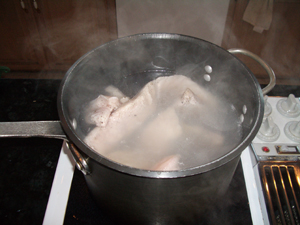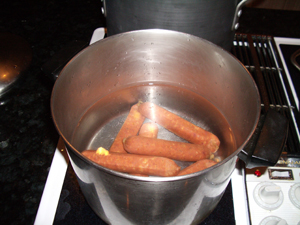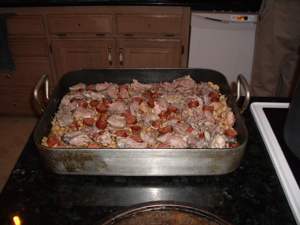Our cassoulet recipe is basically Paula Wolfert's, as described in her book The Cooking of Southwest France. We've made a few minor changes over the years, and we've borrowed a bit here and there from other recipes, particularly Dany's recipe from Cleopatra in Blackheath, NSW. You may find this recipe a bit intimidating, and some of the ingredients challenging, but when all is said and done and baked in a 300F oven for several hours, cassoulet is just franks and beans done up right.
INGREDIENTS
This recipe easily serves two dozen people. You can cut it in half if you wish. Also, this recipe requires a duck confit, duck fat and duck stock. You should make the duck confit at least two weeks in advance so it has some time to ripen.
| • 3 pounds of boneless pork shoulder | Pork butt works as well, but be leery of pork tenderloin; it's rather flavorless. |
| • 4 pounds fresh ham hock or pigs' knuckles | You really want fresh, not smoked hocks or knuckles. These joints have lots of gelatin as well as savory meat. |
| • 2 pound fresh pork skin with a 1/4 inch layer of hard fat attached | This can be tricky to find. Most butchers don't even have access to pig skin, while others may require that you buy 50 pounds as this is the basic distribution unit. We tend to go with Savenor's in Boston. If you just cannot get any pig skin, see if you can get any pork fat back with skin on it, cut off all but 1/4 inch of fat and then blanche it for five minutes. We've done this in a pinch, and it works. |
| • 4 pounds dry white beans | This is a lot of white beans. We tend to use those little Great Northern beans, and they start small but they grow. Our cookbook has a warning never to triple the recipe. We did once and had enough cassoulet for 50 people. |
| • 1 pound bacon | There is a lot of flexibility here. You can use lightly smoked bacon, or pancetta, or lean salt pork. This has to be a fatty bit of pork belly, mid-range in intensity. |
| • 10 tablespoons duck fat from a confit | Did we mention that you'll need about two ducks worth of duck confit to make this dish? Well, you will. Make more and enjoy some duck confit and some cassoulet. |
| • 4 medium carrots | Peel them and cut them into chunks. |
| • 4 medium onions | Peel them and cut them into chunks. |
| • 2 heads of garlic | This is about right, but use more if your garlic is mild. |
| 1 pound European style cured ham | You can use speck, Westphalian ham, prosciutto, Bayonne ham or just about any other "hard" cured ham. |
| • 2 medium tomatoes | Use the best you can get this time of year. |
| • 4 quarts of chicken stock | You can also use duck or goose stock. It is a good idea to make duck stock with the carcasses of the ducks you use in the confit. You can freeze it until cassoulet time. |
| • herb bouquets of 4 sprigs of parsley, 2 sprigs of thyme, 1 bay leaf and 3 short stalks of celery | If you are cooking in more than one pot, you will need to make multiple bouquets garni. Sometimes we use those little cheesecloth bags, sometimes we use a strip cheesecloth held shut with cooking twine. The ratios need not be precise, but we'll say go heavy on the parsley. |
| • 2 pounds of andouilettes | This is a Cajun touch, but we figure that this is a good substitute for the original spicy French sausage. |
| • 2 ducks worth of duck confit | For example, four breasts and four thighs would be about right. You can add more if you want. |
| • 1/2 pound hard pork fat back | You can get by without this, but why? |
| • at least 8 cloves of garlic | Peeled. |
| • 2 pounds garlic sausage | Fresh pork and garlic sausages are best, but you can use Toulouse sausagesor cotechino. |
INSTRUCTIONS
Not counting the making of the duck confit and duck stock, this is a two day recipe. Most of the cooking times are approximate, and perhaps minimal. It is not easy to overcook a cassoulet. The mixture of cooked meats, beans and so on is referred to as the ragout which is French for stew, and in general, this recipe works by browning, preparing, boiling and cooking things and then adding them to the mix. Near the end, the mixture is separated and layered, but in general you will need one large pot that can work on the stove top and one large pot for the oven.
Do be advised that the beans will grow, so don't worry if your pot looks huge in comparison to the mixture. You may wind up needing a second pot anyway. Also, this is a forgiving dish. If you forget to add something, add it later. Precise timing is not as important as putting it all together.
|
THE FIRST DAY
|
|
 |
|
 |
|
 |
|
 |
|
 |
|
 |
|
 |
|
|
THE SECOND DAY
|
|
 |
|
 |
|
 |
|
|
|



